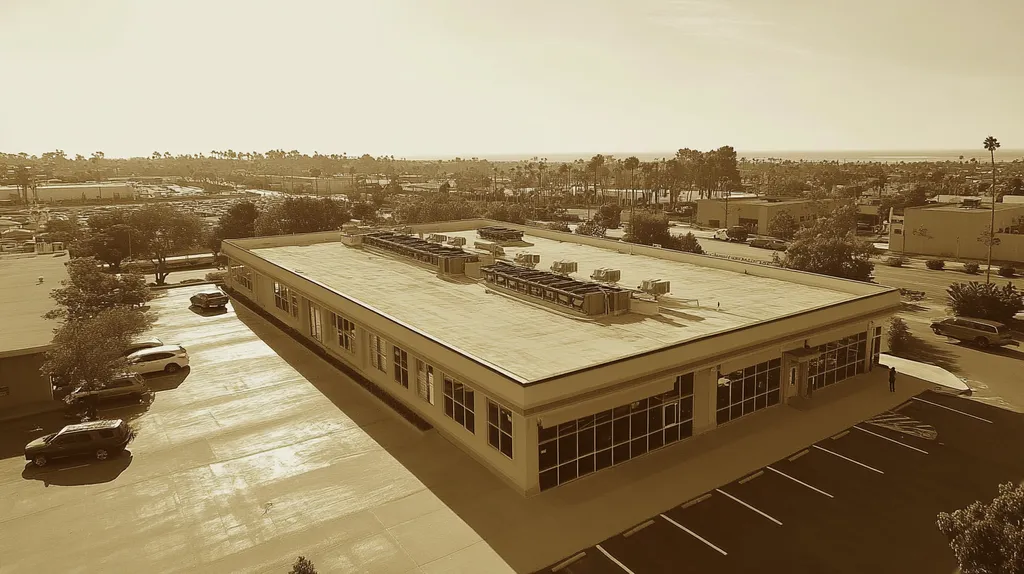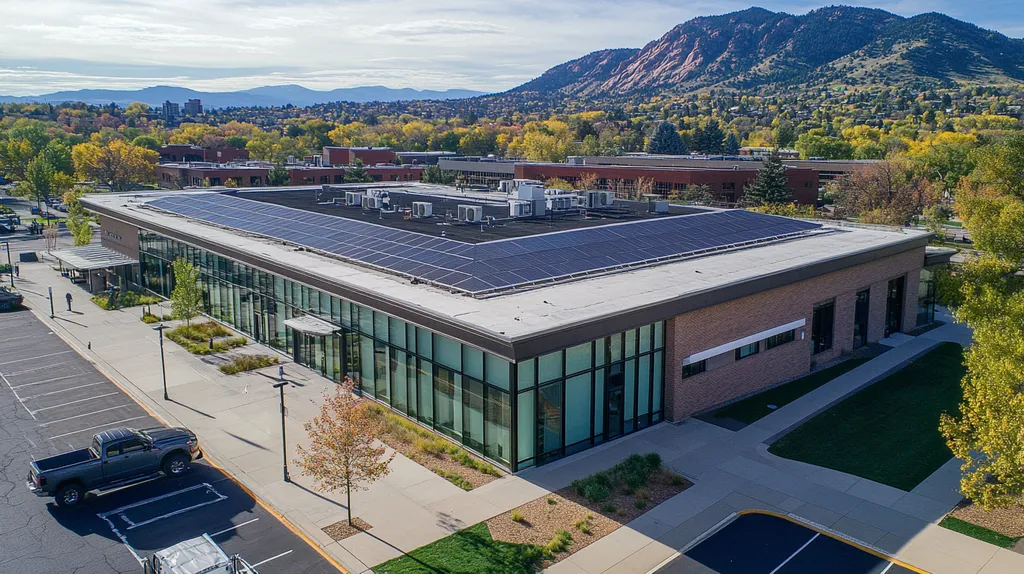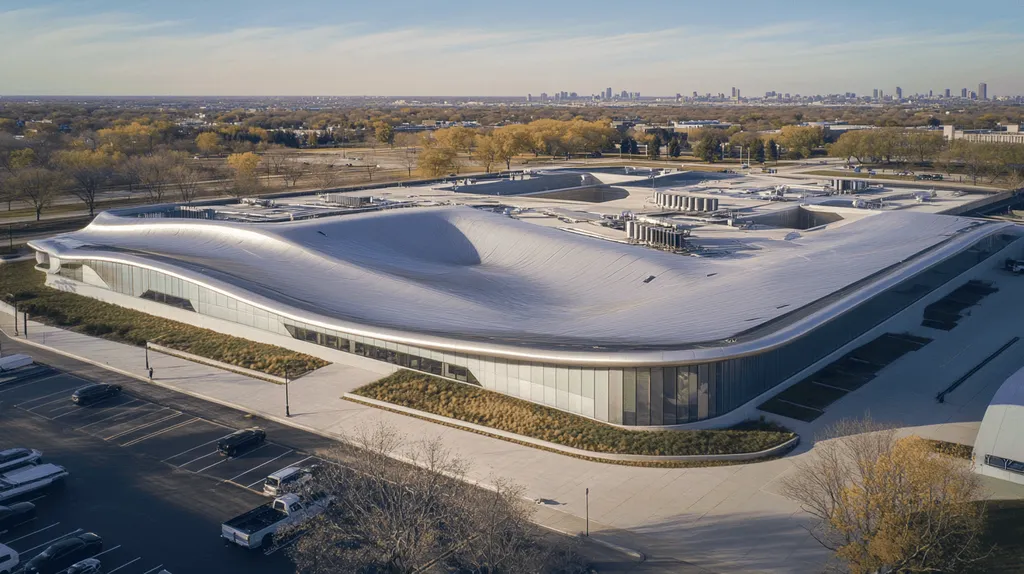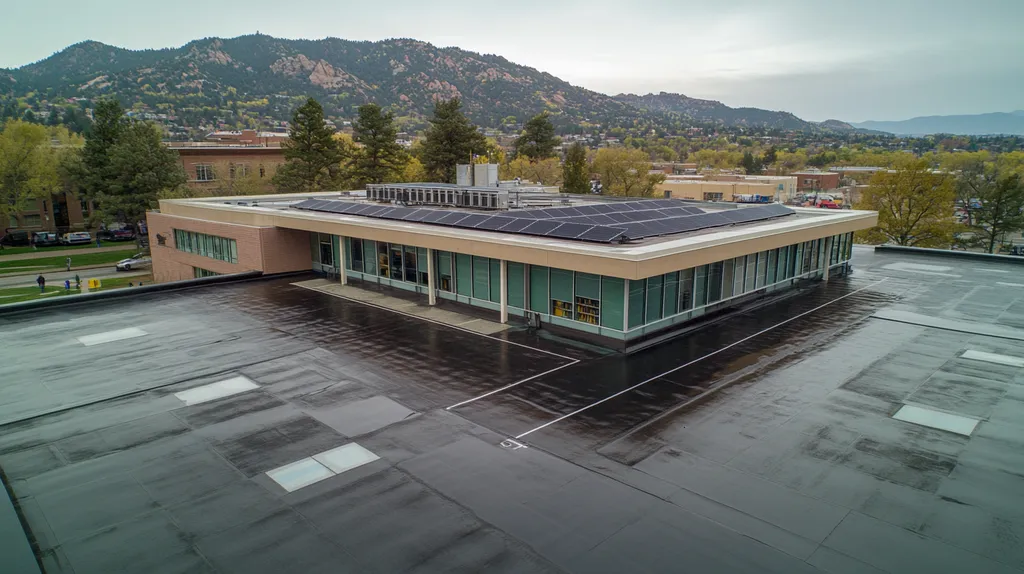As energy costs continue to surge, commercial building owners face mounting pressure to optimize their properties’ solar reflectance. With studies showing that dark roofs can reach temperatures of 190°F in summer, driving cooling costs up by 25%, the financial impact of poor reflectance cannot be ignored.
Recent data from the Department of Energy indicates that buildings with optimized solar reflectance can reduce peak cooling demand by up to 30% and slash annual energy expenses by thousands of dollars.
This comprehensive guide examines critical factors in solar reflectance optimization, from performance metrics and financial considerations to compliance requirements and risk management strategies that protect long-term building efficiency.
SECTION 1: PERFORMANCE FACTORS
Optimizing solar reflectance is crucial for commercial property owners seeking to lower energy costs and enhance overall building efficiency. With buildings responsible for nearly 40% of energy consumption in the United States, improving solar reflectance can lead to significant savings on cooling expenses while promoting sustainability. This section explores essential performance factors that influence roof surface temperature, energy consumption, and effective load management.
Roof Surface Temperature Reduction
Lowering the temperature of the roof surface is vital for reducing energy costs. Dark roofs can soar above 190°F in summer, transferring unwanted heat into buildings and forcing air conditioning systems to work overtime.
High surface temperatures not only drive up energy expenses but also contribute to urban heat islands which worsen local climate challenges. Utilizing reflective roofing materials can significantly cool down these surfaces, resulting in improved indoor comfort and extending the lifespan of roofing systems.
Research indicates that roofs with high solar reflectance can reduce surface temperatures by up to 30°F compared to traditional dark roofs. This cooling effect directly correlates with decreased energy consumption.
Key Action Items
Energy Consumption Impact
The role of solar reflectance in energy consumption is considerable. Buildings equipped with reflective roofs generally use 20% less energy for cooling compared to those with conventional roofing materials, leading to substantial long-term savings.
In the commercial sector, sensitive operational costs make selecting high-reflectance roofing materials a wise choice that can significantly reduce utility bills. Additionally, this approach contributes to lower greenhouse gas emissions, fostering a more sustainable building operation.
Moreover, property owners may access energy incentives or tax credits for adopting energy-efficient roofing solutions. Leveraging these opportunities can help offset initial investments for installing reflective roofing materials.
Key Action Items
Cooling and Heating Load Management
Mastering cooling and heating load management is essential for how commercial buildings regulate temperature. A reflective roof can considerably reduce cooling loads during summer, enhancing HVAC efficiency.
During colder months, these roofing systems help retain internal warmth, minimizing heat loss. This dual advantage boosts both energy performance and indoor comfort.
In fact, an optimized roofing system can lower peak cooling demands by as much as 30%. This reduction elevates energy efficiency and may influence utility rates tied to peak usage.
Key Action Items
SECTION 2: FINANCIAL CONSIDERATIONS
As energy prices continue to rise, commercial property owners must recognize the financial urgency of choosing solar-reflective roofing options. Research shows that roofs with higher solar reflectance can lead to annual energy savings of up to 20%. Understanding the economic benefits of solar reflectance is key for optimizing budgets and making sound financial decisions that enhance operational efficiency.
Energy Cost Savings Analysis
Energy costs often constitute one of the largest operational expenses for commercial properties. Inefficient roofs that absorb too much heat can severely inflate cooling costs during the hotter months. In contrast, roofs designed with high solar reflectance can dramatically lower energy expenditures.
Studies suggest that reflective roofing can save between 10% and 30% on energy bills, particularly advantageous in sunnier regions. By opting for reflective materials, property owners may notice a swift decline in their monthly energy costs.
To calculate possible energy savings, it is essential to assess current energy usage alongside local climate conditions. Geographical factors will significantly influence the benefits; properties in hotter locales will reap the most rewards from reflective roofing.
Key Action Items
Rebate and Incentive Programs
Numerous governments and utility companies offer rebates and incentives to promote energy-efficient roofing practices. These programs can significantly alleviate the initial costs associated with installing solar-reflective materials.
Property owners should investigate tax credits, grants, and rebates available in their locality. For instance, areas may provide financial incentives for installing Energy Star-rated roofing systems, helping tenants save significantly.
Furthermore, some utility companies reward reduced energy consumption, and choosing a reflective roof can qualify properties for such programs. By capitalizing on these opportunities, property owners can turn reflective roofing into a financially savvy and strategic investment.
Key Action Items
Return on Investment (ROI) Calculation
Understanding the return on investment (ROI) for solar-reflective roofing is vital for sound financial planning. Property owners need to weigh the installation costs against the long-term savings from lower energy bills.
A comprehensive ROI analysis should include both direct financial returns and the added value of enhanced property appeal due to energy-efficient features, which can attract environmentally conscious tenants.
Typically, a favorable ROI for energy-efficient upgrades is considered to be around 15% or higher. Property owners can expect competitive returns when investing in reflective roofing solutions, particularly when leveraging available incentives.
Key Action Items
SECTION 3: COMPLIANCE REQUIREMENTS
Complying with relevant regulations is vital for commercial property owners who are serious about optimizing solar reflectance. Neglecting these standards can lead to severe penalties and increased energy expenses. Energy Star certification and local regulations define the necessary reflectance levels, directly influencing sustainability efforts. Familiarity with compliance requirements empowers property owners to make informed roofing choices.
Energy Star Certification Standards
Energy Star certification is crucial for commercial buildings looking to boost solar reflectance. To achieve this certification, roofs must meet specific solar reflectance and thermal emittance benchmarks, such as a minimum solar reflectance of 0.65 for low-sloped roofs.
Not only does certification symbolize energy efficiency, but it can also lead to significant reductions in energy bills. Energy Star certified roofs efficiently reflect sunlight and absorb minimal heat, resulting in lower cooling costs during hotter months. Additionally, properties bearing this certification become more attractive to eco-conscious tenants.
Failing to secure Energy Star certification risks missing out on valuable rebates and tax advantages. Property owners should stay informed about the standards and ensure their roofing materials align with them to fully benefit from these opportunities.
Key Action Items
Local and State Building Codes
Local and state building codes significantly influence the requirements for solar reflectance. These regulations vary by region and dictate the materials and designs permitted in roofing systems. For instance, some areas may require higher reflectance levels for cool roofs in regions with abundant sunlight.
Consulting the local building department is essential for understanding applicable codes. Ignoring these regulations could result in fines and costly modifications, making proactive compliance a more economical approach.
Building codes are often shaped by local climate conditions and sustainability targets. Adhering to these regulations not only helps avoid penalties but also supports community-wide energy efficiency initiatives. Some municipalities may even offer additional incentives for compliance that ease initial material costs.
Key Action Items
Regulatory Compliance Checks
Regular compliance checks are essential to maintain roofing performance and adhere to legal standards. Many jurisdictions require periodic assessments to confirm that roofing systems meet Energy Star and local code specifications. Failure to comply may lead to expensive repairs or system replacements.
These checks focus on both the solar reflectance of materials and the overall quality of the roofing structure. Property owners should maintain thorough records of inspections and necessary improvements, as this documentation can be beneficial during property sales or management evaluations.
Implementing a routine inspection schedule not only fosters compliance but also prolongs the lifespan of roofing systems. Keeping roofs in optimal condition can greatly decrease future energy costs, creating a mutually beneficial scenario for property owners and the wider community.
Key Action Items
SECTION 4: RISK MANAGEMENT
Effective risk management is essential for commercial building owners focused on maximizing solar reflectance while reducing operational costs. The risks associated with inadequate roofing systems can lead to significant heat-related damage and premature roof failure, translating into high repair expenses and energy inefficiencies. Reflective roofing has been shown to cut cooling costs by up to 30%. This section outlines vital strategies for mitigating these risks, including heat damage prevention, addressing durability concerns, and setting up comprehensive maintenance protocols.
Heat-Related Damage Mitigation
Heat-related damage is a critical issue for commercial roofs, especially in warmer regions. High temperatures can cause roofing materials to warp, crack, or even fail, leading to costly repairs. For instance, black membrane roofs often bear the brunt of excessive thermal loads, resulting in significant deterioration.
Choosing reflective roofing materials is a proactive approach to reducing these risks, as they help stabilize temperatures and protect the underlying structure. Regular inspections can identify early signs of heat damage so repairs can be made before more severe issues arise.
Incorporating proper insulation alongside reflective surfaces enhances thermal management and shields the roof from excessive heat stress. This strategy not only extends the roof’s lifespan but also leads to reduced energy costs. A thoughtful investment in reflective roofs pays dividends, delivering both energy savings and lower maintenance expenses over time.
Key Action Items
Weathering and Durability Risks
Weathering is a significant concern for commercial roofing systems, with UV radiation, moisture, and temperature fluctuations leading to deterioration. Roofs with inadequate reflectance run the risk of accelerated damage, resulting in leaks and structural compromise.
Opting for durable, reflective roofing materials can help combat these challenges. Quality coatings enhance both solar reflectance and durability, while warranties from manufacturers provide peace of mind regarding long-term performance against weather elements.
Regular evaluations help identify early signs of weather-related wear, enabling property managers to take timely action. Establishing an annual review can maintain the integrity of reflective properties and facilitate necessary repairs, ensuring sustained building performance and protecting investments.
Key Action Items
Maintenance and Inspection Schedules
Consistent maintenance is key to ensuring that reflective roofing systems deliver optimal benefits. Without regular attention, a roof’s efficiency can quickly decline, resulting in increased energy expenditures and potential damage. It is advisable to conduct inspections at least twice a year, with a focus on identifying wear that affects solar reflectance.
During these inspections, property managers should specifically evaluate roof coatings and check for any surface degradation. Early detection of minor issues can prevent the escalation of more serious problems, protecting energy efficiency and lowering long-term costs.
Engaging qualified roofing professionals for routine maintenance adds immense value, providing insights into materials’ longevity and necessary repairs that may go unnoticed by untrained eyes. Maintaining a detailed log of all maintenance and inspection efforts is essential for informed decision-making and evaluating energy efficiency improvements over time.
Key Action Items
SECTION 5: OPERATIONAL PROCEDURES
Implementing effective operational procedures is essential for maximizing solar reflectance and reducing energy costs in commercial roofing. Without diligent attention to these practices, property owners can face inefficiencies that lead to soaring energy bills and compromised building performance. The U.S. Department of Energy indicates that high-reflectance roofs can slash cooling energy use by up to 20%. This section highlights the critical aspects of installation, ongoing maintenance, and performance monitoring to ensure optimal roof conditions.
Installation and Commissioning Process
The successful installation and commissioning of reflective roofing materials demand precision and adherence to established best practices. Property owners should prioritize hiring installers with a proven track record in energy-efficient materials and techniques. Proper surface preparation is critical for ensuring maximum adhesion, which directly contributes to roof reflectance and longevity.
During the commissioning phase, using infrared thermography can detect areas of heat retention, enabling immediate corrective actions. This proactive strategy helps minimize future energy losses. It’s essential to conduct a thorough walkthrough with installers to verify that the completed system aligns with manufacturer specifications.
Maintaining detailed documentation of the installation process is crucial. This record serves as a vital reference for ongoing maintenance and performance evaluations. Insufficient documentation may lead to misunderstandings that can adversely affect energy efficiency.
Key Action Items
Ongoing Maintenance and Repair
Regular maintenance is critical for preserving solar reflectance over time. Facility managers should establish routine inspections to identify and resolve issues early. Common concerns, such as dirt buildup and membrane damage, can significantly degrade reflectance and overall performance as time progresses.
Cleaning the rooftop surface at least twice a year is essential for sustaining optimal reflectance levels. In urban areas, more frequent cleanings may be necessary due to environmental pollutants. Proper cleaning techniques must be employed to avoid harming reflective coatings.
Along with regular cleaning, inspections must focus on detecting and addressing leaks or membrane punctures. Timely repair efforts ensure the roof’s energy efficiency remains intact, preventing escalation into costly repairs and energy losses. A well-structured maintenance plan promotes roof longevity and continuous energy savings.
Key Action Items
Performance Monitoring and Reporting
Monitoring performance is foundational for assessing the effectiveness of solar reflective roofing systems. Adopting energy management software can deliver real-time insights into energy consumption, guiding property management decisions and pinpointing areas for improvement.
By setting key performance indicators (KPIs), facility managers can measure energy usage against established benchmarks. Regular reporting on these metrics ensures that any unusual energy performance can be swiftly addressed, thus preventing unnecessary costs.
Cross-referencing performance with similar facilities allows property owners to objectively evaluate their roof’s effectiveness. This comparative analysis amplifies best practices in maintenance and enhances operational efficiencies. Engaging third-party service providers for independent evaluations can further promote transparency and accountability.
Key Action Items
SECTION 5: OPERATIONAL PROCEDURES
Effective operational procedures are critical for maximizing solar reflectance and minimizing energy costs in commercial roofing. Without steadfast attention to installation and maintenance, property owners may face energy inefficiencies that significantly inflate bills and jeopardize building performance. High-reflectance roofs can potentially cut cooling energy use by as much as 20%, according to the U.S. Department of Energy. This section highlights essential steps in installation, ongoing maintenance, and performance monitoring to ensure that roofing systems remain effective and energy-efficient.
Installation and Commissioning Process
The installation and commissioning of reflective roofing materials demand meticulous attention and adherence to industry best practices. Property owners should prioritize hiring installers experienced with energy-efficient materials and techniques, ensuring that surfaces are adequately prepared to maximize adhesion. Proper surface preparation plays a vital role in enhancing both reflectance and durability.
During the commissioning phase, infrared thermography can be utilized to detect heat retention areas, prompting immediate corrective actions. This proactive measure helps thwart future energy losses. It’s essential to conduct a thorough walkthrough with the installation team to ensure that the finished system aligns with manufacturer specifications and energy codes.
Keeping detailed documentation throughout the installation process is crucial for future maintenance and performance evaluations. Inadequate records can lead to miscommunication, which can negatively affect energy efficiency over time. A solid installation lays the groundwork for effective roof performance, unlocking potential energy savings.
Key Action Items
Ongoing Maintenance and Repair
Regular maintenance is essential to sustain solar reflectance and ensure long-term energy efficiency. Facility managers should implement routine inspections to identify and resolve issues promptly. Common challenges, such as dirt buildup and membrane damage, can compromise both reflectance and overall roofing performance over time.
To maintain optimal reflectance levels, cleaning the roof surface at least twice a year is advisable. In urban areas, more frequent cleanings may be required due to environmental pollutants. It is crucial to employ appropriate cleaning techniques to protect reflective coatings from damage.
In addition, regular inspections should focus on identifying and addressing leaks or membrane punctures promptly. Timely repairs prevent escalated energy costs and preserve indoor temperatures. A well-planned maintenance strategy not only extends the roof’s lifespan but also supports ongoing energy savings.
Key Action Items
Performance Monitoring and Reporting
Performance monitoring is crucial for evaluating the effectiveness of solar reflective roofing systems. Implementing energy management software can provide valuable real-time insights into energy consumption patterns, guiding property management decisions and identifying potential areas for improvement.
Establishing key performance indicators (KPIs) allows facility managers to track energy usage against benchmarks. Regular reporting on these metrics helps swiftly address any unusual energy performance, preventing unnecessary costs. Consistent tracking can lead to better decision-making and enhanced operational efficiency.
By benchmarking performance against similar facilities, property owners can objectively assess their roof’s effectiveness. This analytical approach drives adoption of best practices in maintenance and optimization. Collaborating with third-party service providers for independent evaluations can further improve transparency and accountability.
Key Action Items
The Bottom Line
With commercial buildings accounting for nearly 40% of U.S. energy consumption and cooling costs rising by up to 25% due to poor solar reflectance, property owners can no longer afford inaction on roof optimization.
Studies consistently demonstrate that high-reflectance roofing systems reduce peak cooling demand by 30% while extending roof lifespan by up to 15 years.
As regulations tighten and energy costs surge, implementing comprehensive solar reflectance strategies has evolved from an optional upgrade to a critical business imperative.
The integration of proper materials, maintenance protocols, and monitoring systems creates a framework for sustainable energy management that delivers measurable returns.
Property owners who fail to optimize their roofing systems risk not only escalating operational costs but also declining property values in an increasingly efficiency-conscious market.
FREQUENTLY ASKED QUESTIONS
Q. How does solar reflectance affect commercial roofs?
A. Solar reflectance is critical for managing roof temperatures, significantly reducing unwanted heat absorption. Lower temperatures decrease the workload on cooling systems, translating into energy savings and longer lifespan for roofing materials. A well-optimized roof enhances both building performance and indoor comfort.
Q. What are the key financial benefits of a reflective commercial roof?
A. Reflective roofs can lead to energy savings of up to 30%, significantly lowering cooling costs. This choice also opens doors to rebates and tax credits, enhancing return on investment. By reducing energy expenses, property owners can allocate financial resources more effectively.
Q. What compliance requirements should I consider for my industrial roof?
A. Property owners must align roofing materials with Energy Star certification standards and local building codes governing reflectance. Compliance with these regulations helps avoid penalties, reduces energy costs, and contributes to sustainability goals, ensuring a responsible roofing solution.
Q. How can I mitigate risk associated with commercial roofing?
A. Effective risk management involves using reflective materials, regular inspections, and maintaining comprehensive maintenance schedules. By tackling heat-related damage and weathering risks, property owners can extend roof life, minimize repair costs, and improve energy efficiency over time.
Q. What operational procedures optimize solar reflectance?
A. Key procedures include hiring experienced installers, conducting regular maintenance, and utilizing energy management software. Establishing proper installation and ongoing checks help ensure that the roofing system remains energy-efficient while maximizing performance and minimizing operational costs.
Q. How does cleaning impact reflective roofs?
A. Regular cleaning is vital for maintaining solar reflectance levels, as dirt and debris can degrade roofing performance. Cleaning surfaces at least twice a year helps to ensure that reflective coatings function effectively, promoting energy efficiency and prolonging roof lifespan.
Q. What specific roofing materials are best for solar reflectance?
A. Selecting materials with high solar reflectance ratings, such as white PVC, TPO membranes, or reflective coatings, greatly enhances energy efficiency. These materials are designed to minimize heat absorption and manage roof temperatures effectively, helping to maximize overall performance.











